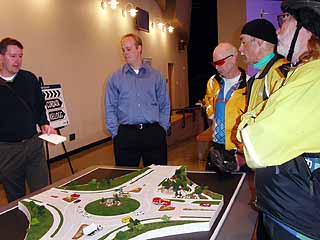|
Subscribe / Renew |
|
|
Contact Us |
|
| ► Subscribe to our Free Weekly Newsletter | |
| home | Welcome, sign in or click here to subscribe. | login |
Construction
| |
 |
September 16, 2004
Staving off the pitchforks and torches
Reid Middleton

Photo courtesy of Reid Middleton
A group of cyclists check out a model of a roundabout at an open house in Bellingham. The city used the public involvement process to bring citizens up to speed on the city’s newest traffic-control tool.
|
Nothing evolves into a call-to-arms of pitchforks and torches quite like a public agency proposing transportation improvements.
We all bemoan traffic challenges, but when the proposed project affects us directly, we seem to take on a different attitude. Why? The most common reasons are:
- Change — we humans often seem most comfortable with the way things are.
- NIMBY-ism — "Not in my backyard" attitudes.
- Misunderstandings and fear — generally over solutions that are not understood and how the proposed projects will be funded.
From the controversy surrounding a third runway at Sea-Tac Airport to the challenges surrounding the Seattle monorail, the need for transportation improvements seems to lend itself to disagreement, varying opinions and, occasionally, the emotional "pitchforks and torches" of discord.
From pitchforks to unity
Public involvement done well has the potential to create harmony where discord reigns. Community unity and project success are interdependent. Without a well-delivered public involvement process, those in opposition feel they have no voice, those in favor don't have a chance to show their support, and the opportunity to engage in consensus-building is lost.
A public agency proposing improvements also faces the possibility of organized community opposition, resulting in a stalled project, or worse, a lawsuit.
The city of Bellevue is a strong believer of integrating public involvement into its transportation programs.
According to Tresa Berg, public involvement manager for the city's transportation department, "[Through] early and effective public involvement and interaction with the affected community, the city can build community support, inform the public, and more importantly, help them find meaningful ways to provide their input on critical transportation improvements in a targeted, systematic approach."
The city successfully uses a variety of media and outreach tools to gain active community participation in its projects.
Ensuring success
Public involvement provides a forum for the exchange of information, analysis and concerns, leading to more thoughtful decision-making and greater accountability. A successful public involvement program helps empower the project stakeholders.
How the public involvement process is approached and applied depends on many factors — the scope and type of project, its budget, the number of stakeholders, alternatives, short-term and long-term impacts and community culture, to name a few.
Regardless of the approach and application, the process for each public involvement effort must contain these components to ensure success:
Communication — Not everyone has Internet access, nor does everyone read the paper. Knowing and applying what works well with affected constituents, and using those communication tools early and often will help drive success.
Reaching stakeholders throughout the process is key. Informational posters, door hangers, open houses, Web sites, questionnaires, bulletin boards, newsletters, newspapers, "town halls," radio, TV, cable-access programs, direct mail — these are all meant to reach different audiences.
Visual communication is an often overlooked, though powerful tool, especially when sharing proposed solutions. Photographic renderings and 3-D models of solutions or alternatives allow stakeholders to really see what the proposed ideas will look like and gives them a sense of how it will "feel."
Joy Monjure, education coordinator for the Public Works Department in Bellingham, has been using television for over four years now because of its broad outreach. Her philosophy is simple, but motivated by the results it generates: "Let's take this medium and use it for the common good."
Recognizing that stakeholders don't have the time to attend public meetings, Monjure brings the meetings to them. She has had many Public Works meetings professionally videotaped and aired on Bellingham's cable-access channel. The programming has a far-reaching and positive effect in getting the word out on upcoming projects and educating constituents on important issues.
A recent example includes a video designed to inform Bellingham citizens about upcoming plans to construct the city's first roundabouts. The video, which included footage of an open house, covered driving rules for roundabouts and explained their safety benefits.
Participation — a typical transportation project, regardless of its size, will affect a variety of stakeholders, from business owners to property owners and elected officials. Representatives from each of these groups need to be a part of the discussion.
An agency needs to pay heed to the barriers to participation as well and work to eliminate these as a way to encourage more meaningful involvement:
- Lack of awareness of the proposed project, or of the opportunities to get involved in the discussion.
- Inaccessibility of information.
- Complexity and duration of the process.
- A perception on the part of the public that their opinions won't matter.
- Preconceived solutions.
Organization — the synergy that exists throughout a thoughtfully orchestrated public involvement process can easily be lost if not monitored routinely for effectiveness, and in response, be flexible to change.
A public involvement process that cultivates a sense of ownership and allows stakeholders to air their views is the best testament to its success. This is democracy at its best: government by the people, for the people.
Kelli Owen has practiced civil engineering at Reid Middleton for more than 18 years. Her focus is transportation solutions for public agencies.
Other Stories:
- A cheaper way to treat runoff
- Skagit Station offers hope for renewal
- Light-rail line hits fast forward
- Creating a seamless regional transit system


